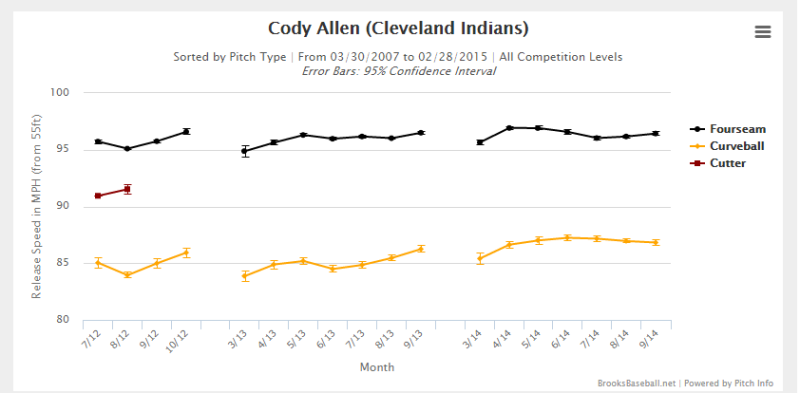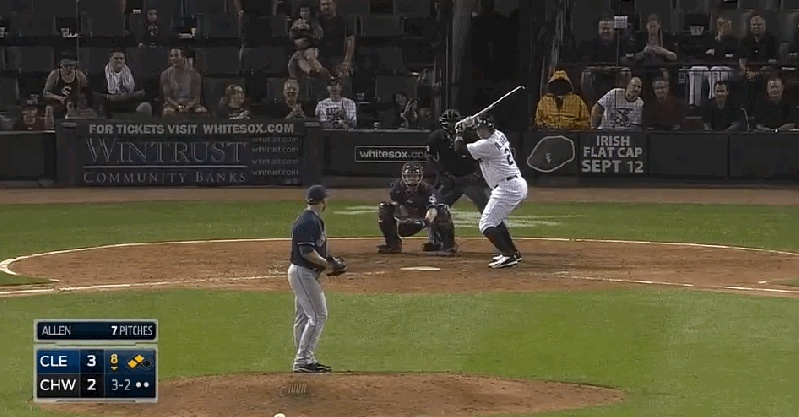 In baseball, unless one is named Craig Kimbrel or Mariano Rivera, an elite reliever can go unnoticed and under-appreciated as the only relief pitcher outcome noted by fans is that of failure. Much like the offensive line in football, allowing pressures; big league bullpens are noticed most frequently when blowing leads rather than protecting them.
In baseball, unless one is named Craig Kimbrel or Mariano Rivera, an elite reliever can go unnoticed and under-appreciated as the only relief pitcher outcome noted by fans is that of failure. Much like the offensive line in football, allowing pressures; big league bullpens are noticed most frequently when blowing leads rather than protecting them.Cody Allen has been the best reliever on one of the best teams in baseball the last two years and not many people outside of the AL Central know his name. This probably doesn't bother Allen, a quiet anchor whose rise to dominance was speedy but under the radar.
Allen, a 23rd round pick first pitched in the Indians organization in 2011 was contributing to the big league club in late 2012, though relievers such as Allen can move quickly this was truly ascendant.
In 2014, Allen was outstanding, posting a 2.07 ERA good for 18th among relievers with at least 60 innings, further Allen posted the 12th best K/9 at 11.76. Though strikeout rates, are central to any pitchers success, when your highest leverage reliever posts elite K-rates, that is an immense positive.
This is because, batted ball outcomes are often fluky, and can skew realities in the late innings, thus limiting contact, especially with runners on base makes negative outcomes less likely. This is one of the biggest reasons why people use K/9 frequently when discussing relievers and starters.
K/9 is especially important in tenuous situations, for instance runners in scoring position with a lead of 3 runs or less, where limiting contact is essential to run prevention. What's more, Francona began to use Allen as a true high-leverage reliever in 2014.
Allen appeared in the 7th inning once, the 8th inning 32 times, the 9th inning 46 times, and extra innings 5 times. 8 times Allen was brought in to close the door on a run scoring opportunity and then pitched another inning to end the game, which is why his swing and miss ability is so essential.
So how does Allen do it? What mix creates such devastating production?
In looking at a pitchers arsenal, I believe that one of the great products of analytics/sabermetrics is our ability to enhance our visualization of data. Often we can get lost in numbers or use them rhetorically to blind those who disagree, often it is deceptive as poet Robert Lang is attributed as saying: "He uses statistics as a drunken man uses lamp posts—for support rather than illumination."
But the movement to show data in chart and visual form, I believe truly helps to illuminate baseball in various insightful ways.
First lets talk about velocity the lifeblood of an elevated strikeout rate, well as you can see below, Allen is blessed with significant velocity:
 |
| Courtesy of Brooks Baseball |
Prior to 2014, Allen had been below average at doing so, however, in 2014, the league average was 60.6% and Allen posted 62.7%. This denotes, that Allen was able to control his fastball and create an advantage in counts. Further, Allen posts above average whiff% with his fastball, because of both his ability to locate and the velocity.
Recent work has confirmed the old baseball assumption that elevated velocity at the top and above the strike zone can induce a lot of swing-and-miss, Allen has taken advantage:
 |
| Courtesy of Brooks Baseball |

If you were to design a secondary offering, it would be one which drastically changes the eye-level of the hitter, with valuable vertical movement so as to make the bottom of the strike zone equally devastating. Allen of course has such a pitch.
PITCHf/x defines pitches by their movement along the x-axis and y-axis as well as other factors, and it has had issues deciding whether Allen throws a curve, knuckle-curve or slider. Whatever name you want to assign it, this is a filthy offering valuable downward movement (Brooks Baseball defines it as a curveball).
[caption id="attachment_2960" align="aligncenter" width="456"]
 Courtesy of Brooks Baseball[/caption]
Courtesy of Brooks Baseball[/caption]I will allow the reader to draw their own conclusions, however, Allen obviously targets low and away on right handed batters with the curveball. Allen magnificently complements his two offerings in order to vertically expand the size of the strike zone.
Allen has a dynamic two pitch mix, strong control and exhibits all the markings of dominance.
The conclusion is simple, Allen is an elite back end guy because of his ability to induce swing-and-miss which is derived from two plus offerings.
Attrition is always a concern with bullpen types, but for now Indians fans, revel in the ability and smokeshow that is Cody Allen.

0 comments :
Post a Comment